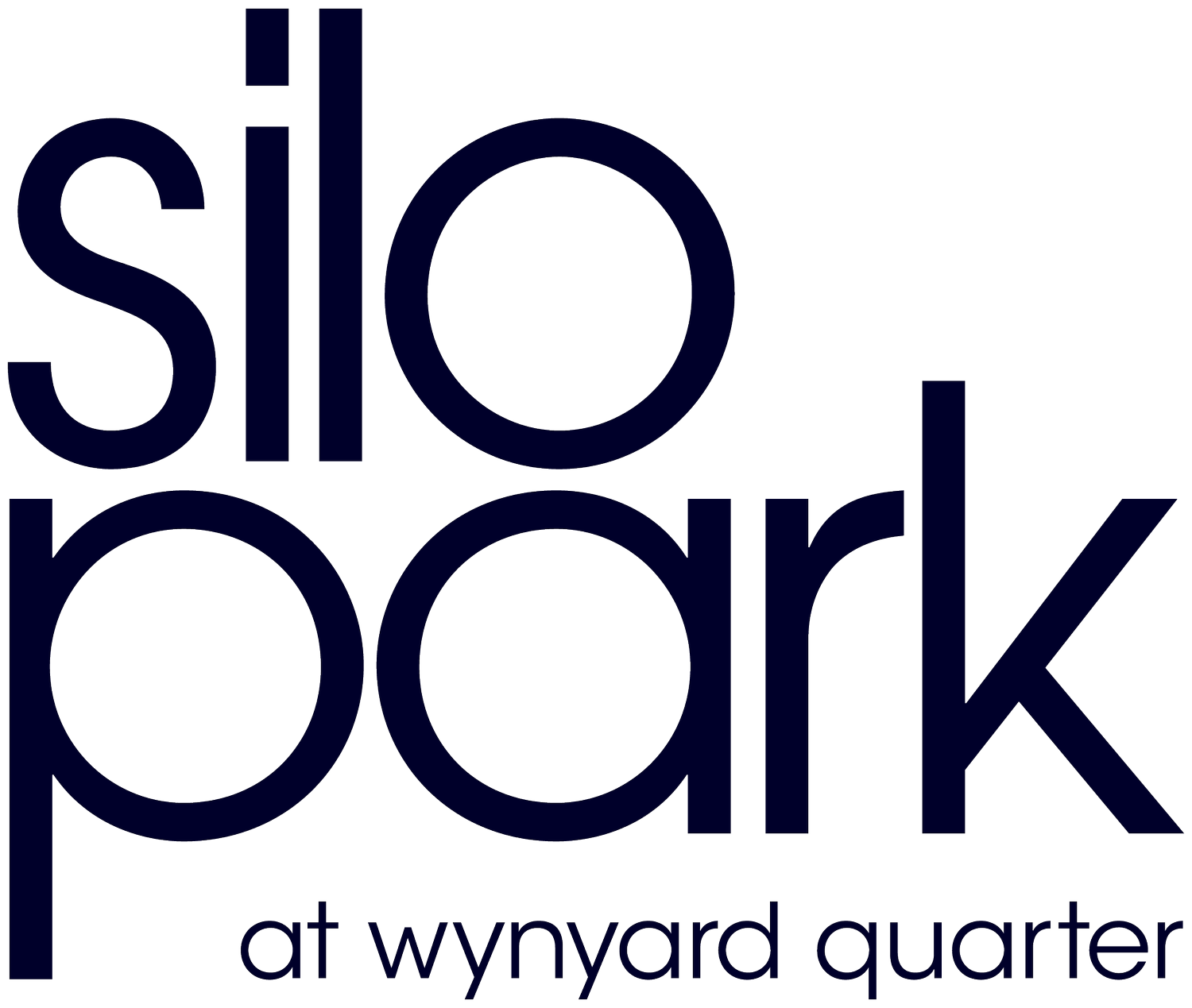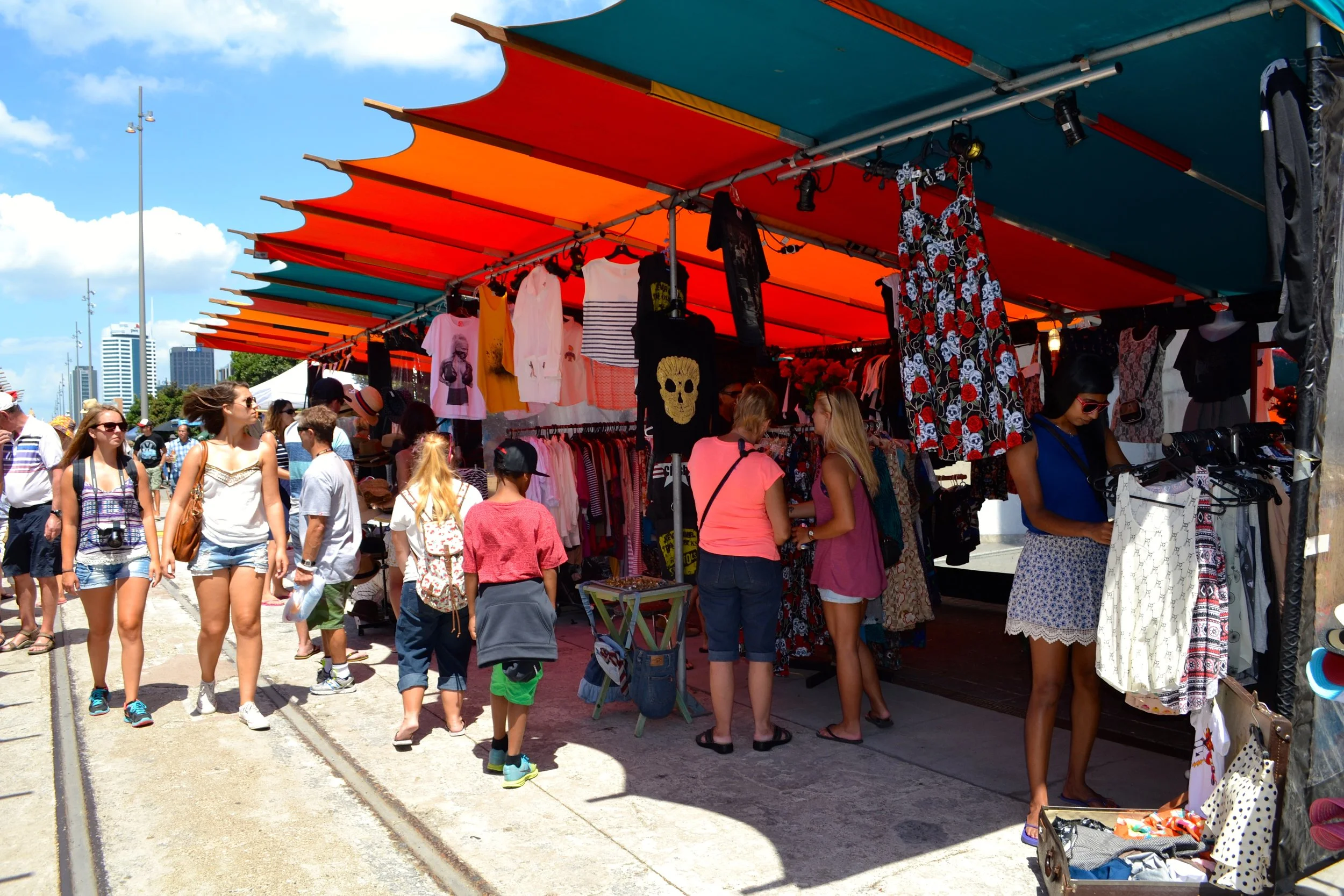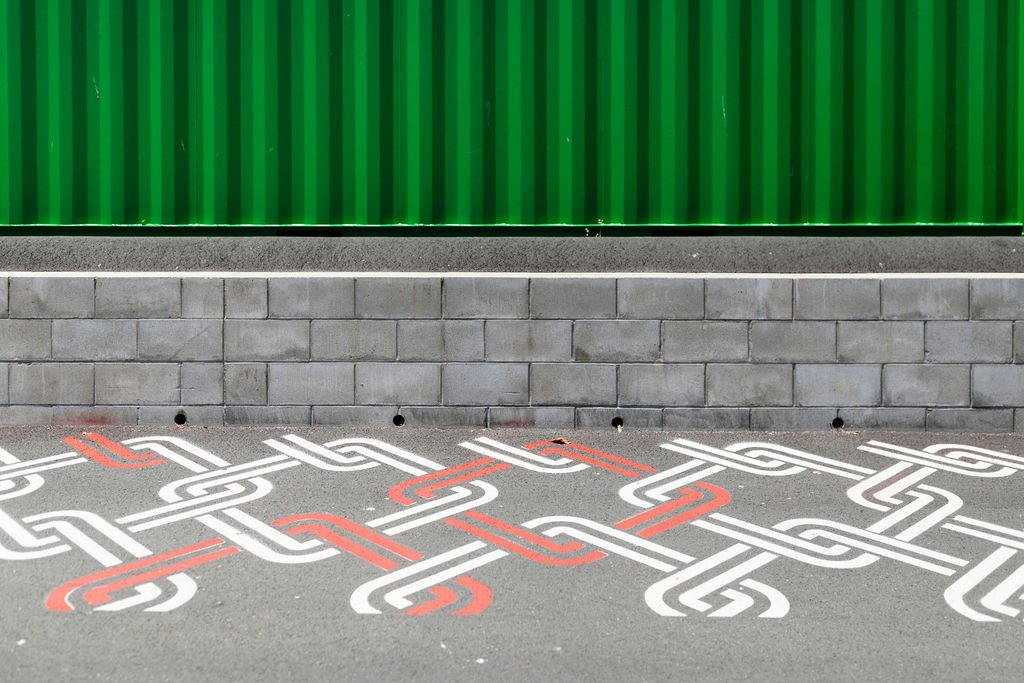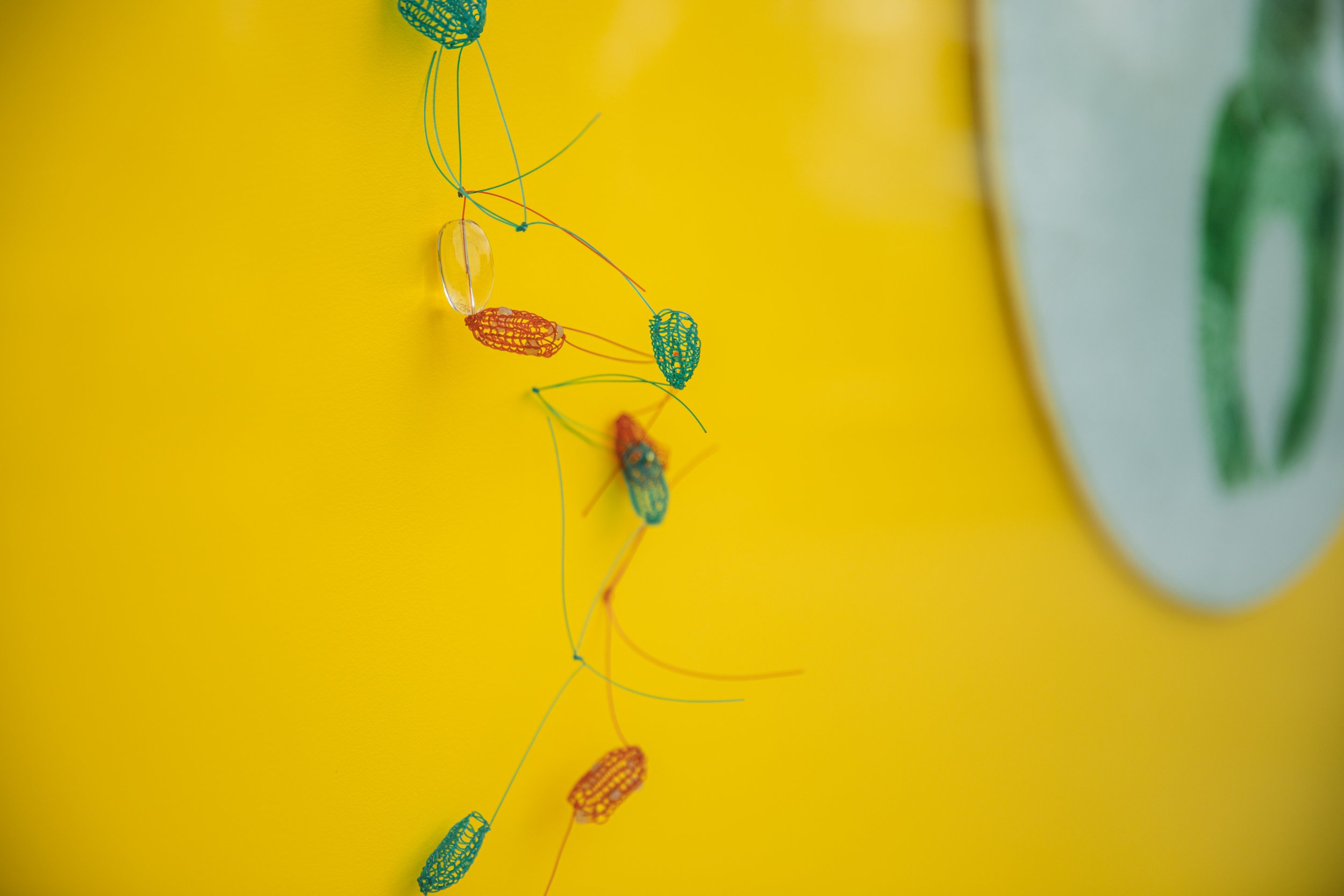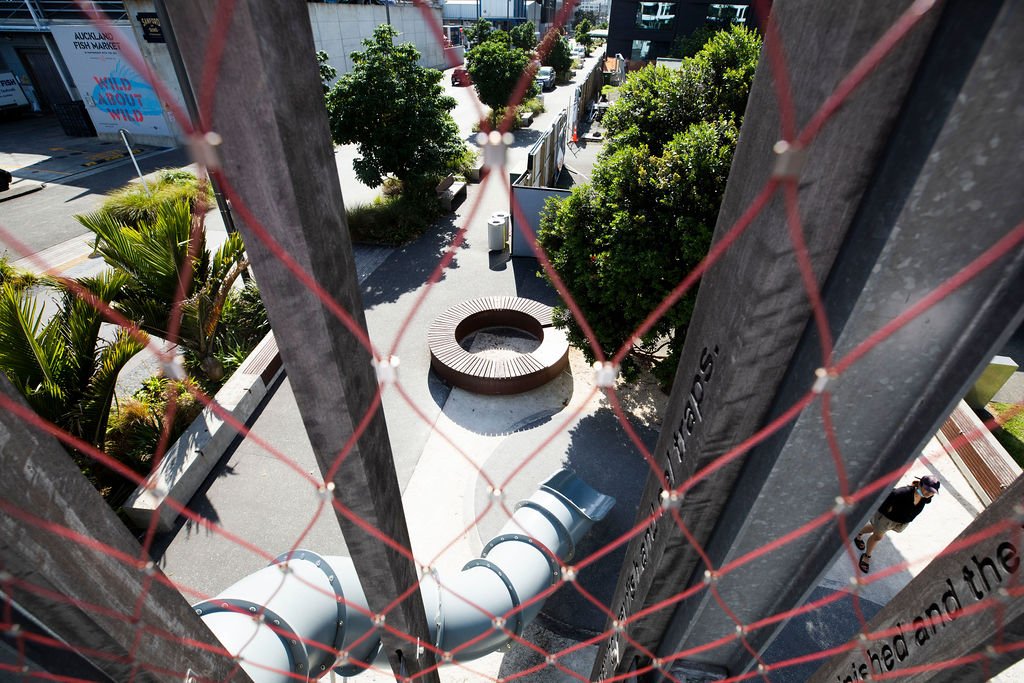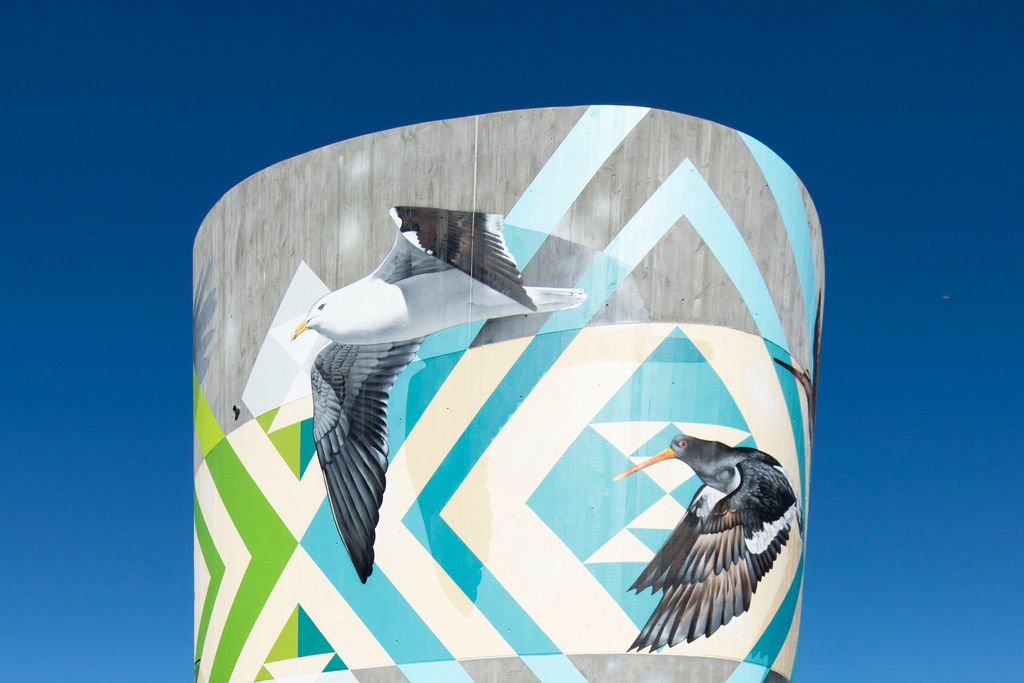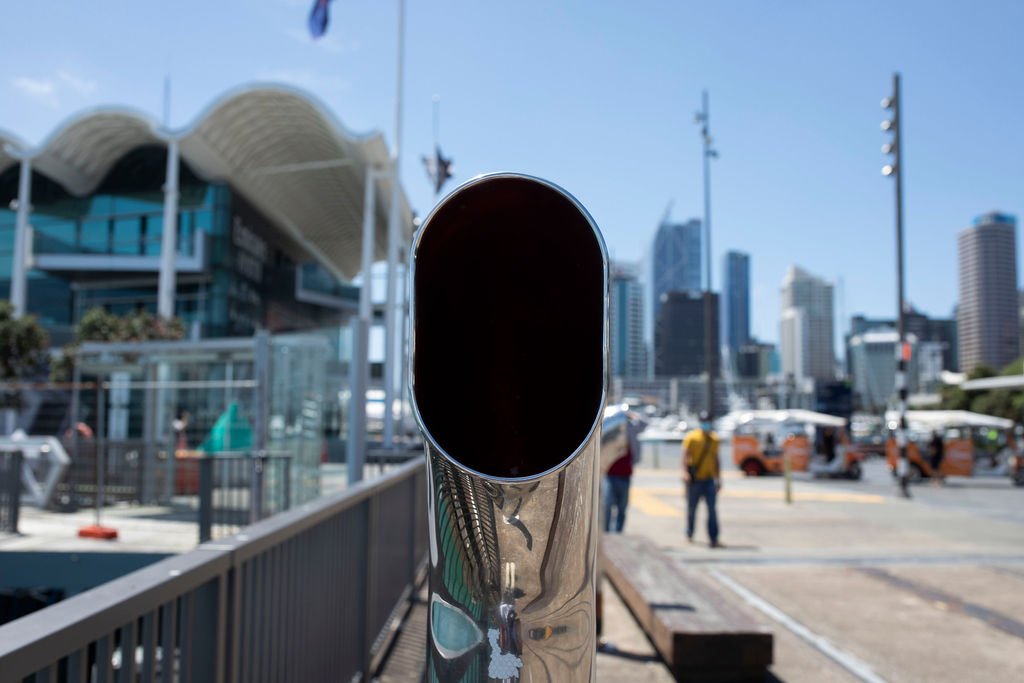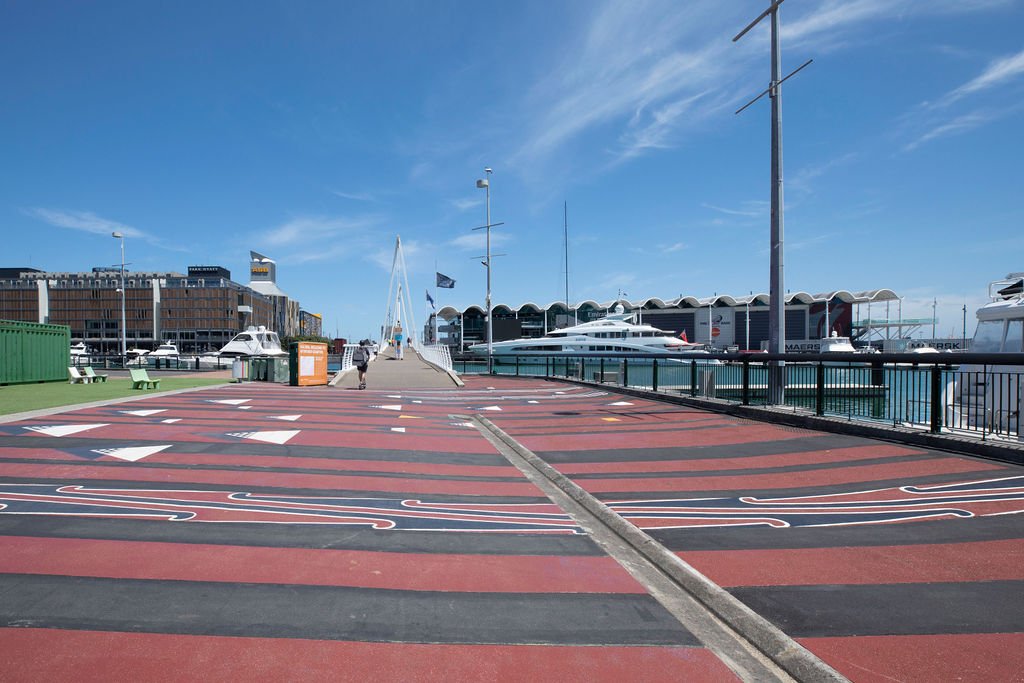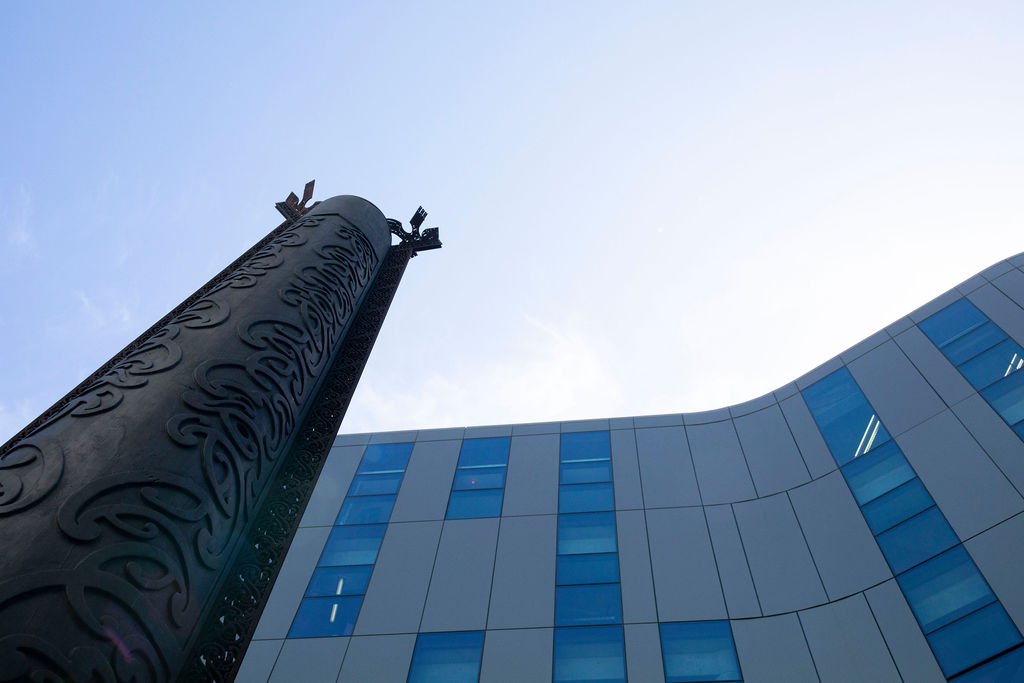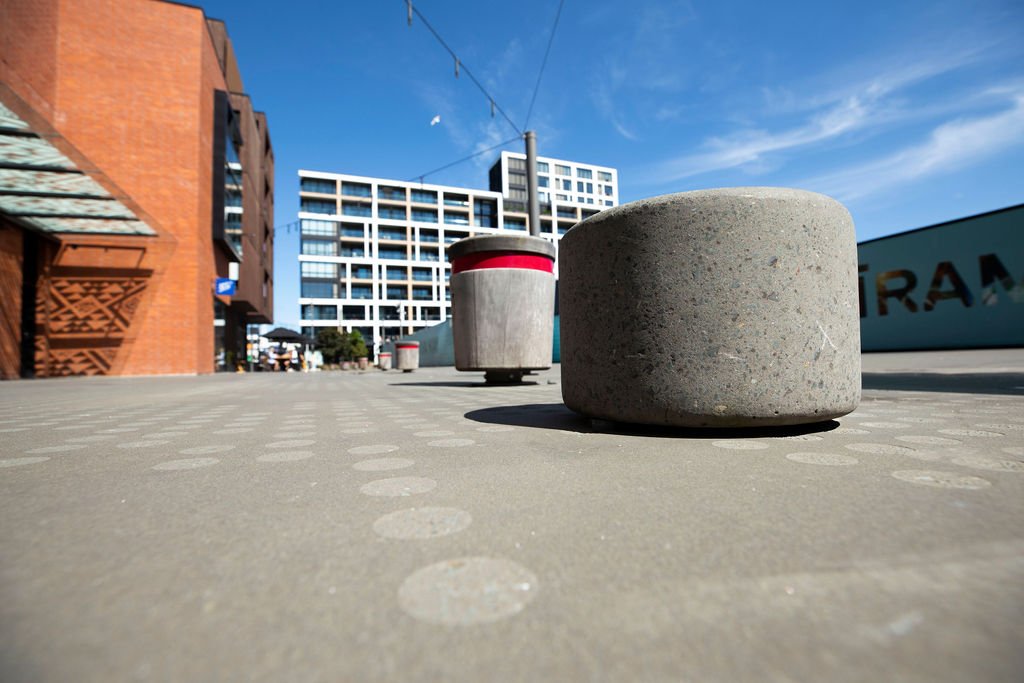Come & explore the incredible art dotted around the Wynyard Quarter against the picturesque canvas of the Tāmaki Makaurau waterfront.
The waterfront is home to a vibrant display of public artworks suitable for all ages. We’ve put together a handy downloadable map, to help you find all the awesome art that the Wynyard Quarter has to offer!
There are many mahi toi (art works) that have been created by Māori artists in collaboration with mana whenua across the waterfront, rich in both narrative and artistic disciplines. From traditional Māori weaving and carving, to sculpture and mural painting, Eke Panuku has been working with mana whenua to seek opportunities to elevate and showcase māori toi across the waterfront so that tangata whenua can see themselves and their culture in the modern landscape of Tāmaki Makaurau.
You may have seen and played on art across the waterfront and wanted to know who created it, or what it's called? Keep reading below to find out more about each work of art.
Download the map here
The Works
Ngā Whakarere Tīponapona
By Reuben Kirkwood (Ngāi Tai ki Tāmaki)
Te Nukuao
By Tessa Harris (Ngāi Tai ki Tāmaki)
Te Nukuao which means ‘shelter’ is both a marker and a signal of the deep connections tangata whenua maintain as kaitiaki of the land and waters of Tāmaki Makaurau. Artist Tessa Harris of Ngāi Tai ki Tāmaki explores the narrative, form, and symbolic presence of waka hourua sails as a design driver and reference to the history of Wynyard Quarter as a 'water space' pre-reclamation. The waka inspired structure Te Nukuao, explores three waka hourua sails and is about journeys, both past and present, and the space it creates offers shelter from the elements.
Te waka o rangi whetū
By Reuben Kirkwood (Ngāi Tai ki Tāmaki)
Wind Tree
By Michio Ihara, 1972
Materials: stainless steel
Wind Tree, by artist Michio Ihara, is one of five artworks produced as a result of the Auckland International Sculpture Symposium held in September 1971.
It was first installed in Queen Elizabeth II Square in 1977 and was subsequently moved to its new home at Wynyard Quarter in 2011.
The trusses swing in the wind and the pool below reflects light up through the sculpture. It claims and transforms the space through water, movement and light.
It’s made from stainless steel, is 22 metres long, 5 metres wide and 5.5 metres high.
Sounds of Sea
By Company (Finland/Korea), 2011
Materials: stainless steel and powder-coating
Sponsor: Waterfront Auckland, Public Art and Landmark Incorporated
Sounds of Sea by Helsinki-based design duo Company is a playful artwork that invites people to interact with it. The sculpture references the ventilation funnels and speaking tubes used on ships. Sounds of Sea is poetic, light-hearted and fun, and an innovative and contemporary nod to the history of the area. The work exemplifies the way in which creativity can celebrate a city's heritage.
Waihape
By Reuben Kirkwood (Ngāi Tai ki Tāmaki)
The new surface panels within Eastern Viaduct are the mahi toi of mana whenua artist Reuben Kirkwood of Ngāi Tai Ki Tāmaki. The artwork connects to the other surface work Reuben Kirkwood has designed for the 36th America’s Cup on the breakwaters, along Hamer Street and within Silo Park extension.
The artwork is inspired by the silhouette of a waka hourua sail and the design represents the rā kautū (upright triangular sails of waka hourua scattered across the Waitematā). The concept whakarauika (to gather together) is displayed within the centre overlap of the two sails as smaller internal triangles. Groups of waka sailing in the same direction are easily identified with their sails pointing in the same way. Fleets of wind-blown waka are arranged as sailing one way or the other to signify the name Waihape, meaning ’to tack’ in sailing.
Daldy Street Play Structure
By Hana Maihi (Ngāti Whātua) & Delani Brown (Ngāti Tūwharetoa, Raukawa)
Architects: LandLAB, Landscape Architects
This play structure was a collaboration between Waterfront Auckland and Ngāti Whātua o Ōrakei, and it incorporates Māori storytelling. Ngāti Whātua o Ōrakei commissioned the artists, Hana Maihi and Delani Brown. LandLAB modelled the structure’s architecture on the form of a hīnaki (eel trap). Its circular arrangement, inner entry tube and netting design all replicate the forms of sticks, flax netting and cordage elements used in the traditional Māori traps. Symbols for water and whakataukī (proverbs) relating to water complement the play structure. Stories about the harvest and maramataka (lunar cycle) are used in the carved timber pou (posts) with their pāua (abalone) shell inlay.
Mai i ngā maunga ki te moana
By Janine Williams (Ngāti Paoa, Ngāti Whatua o Kaipara) & Charles Williams (Ngāti Kahungunu, Ngāti Tūhoe, Ngapuhi)
The artists were appointed to curate a work that brings beauty and cultural interpretation to the concrete pump station and contributes to cultural expression on the waterfront.
At 12 metres high and spanning 16 metres wide around the pump station structure, the mural features 12 native birds to remind us of our roles as kaitiaki (guardians) of our natural environment. Each manu (bird) faces their respective habitats, be it moana (ocean), takutai (beach/shore) or pararau/repo/maunga (forest/swamp/mountains).
The work responds to the physical location of the pumpstation and the orientation of the structure within its geographical position in Tāmaki Makaurau. The placement and colour selection of the design reflects the natural habitat of the chosen birdlife (in consultation with mana whenua) while showing the comparisons of their physical size.
The birds included in the mural are:
Kuaka - Bar-tailed godwit
Karuhiruhi / Kawau - Pied shag
Tarāpuka - Black-billed gull
Pakahā - Fluttering shearwater
Kāka
Warou - Welcome swallow
Kōkako - Blue-wattled crow
Korimako - Bellbird
Pūkeko - Purple swamphen
Karoro - Southern black-backed gull
Puhoro kāhui
By Reuben Kirkwood (Ngāi Tai ki Tāmaki)
Silt Line
By Rachel Shearer and Hillery Taylor, 2011
Materials: cast concrete, tidal steps and sound installation.
Silt Line, which sits in the stair risers at Karanga Plaza, is a graphic representation of the clusters of frequencies that make up the compelling sound installation The Flooded Mirror.
Shearer has described the work as "an aural map of ancient general histories and specific recent histories".
Waharoa
By Blaine Te Rito (Ngāti Kahungunu, Ngāpuhi, Ngāti Waiora)
Ngāti Whātua Ōrakei, in consultation with other iwi groups, commissioned a group of traditional Māori carvings for the 2001 America’s Cup Village.
The waharoa (gateway) depicts Māui who fished up the great fish, Te Ika-a-Māui (New Zealand’s North Island) and his older brothers. Māui’s brothers didn’t want to take their young brother fishing but found him hidden in the hull of the boat when they dropped anchor. Māui pulled out a strong line with a hook his grandmother Muri-ranga-whenua gave him; the hook was made from an ancestral jawbone. That day his brothers had their most bountiful catch and Māui pulled up the greatest prize of all, the Te Ika-a-Māui (North Island).
Papatūānuku
By Mei Hill (Ngāti Whātua, Ngā Puhi, Te Aupōuri, Te Rarawa)
Ngā Rawa: He karāhe, he pepa, he kakatahi horihori, he kiriaku
Whakaata ai a Papatūānuku i te hurihuri o ngā tae me ngā tau i ngā taiao tūroa, i ngā hononga ā-rangi hoki e whakaawetia nei e te maramataka. Ko ngā poi karāhe e whakaatu ana i ngā karere wairua, ā, ko tā ngā tae ngangahau o te pātū he whakaatu i a Tama-nui-te-rā, i te ahi-kā-roa hoki, otirā, i taku whānau o Ōrākei e tiaki ana i ngā ahi kia kā tonu i te puku o Tāmaki Makaurau. I taku tūranga hei ringatoi, e ū ana au ki te whakatinana i te kaitiakitanga, ki te whakahou hoki i te whakamahinga o ngā rawa e auahatia ai “he mea hou, he mea mino, he mea kahurangi hoki”.
Materials: Glass, paper, polymer monofilament, acrylic
Papatūānuku reflects the ever-changing colours and seasons within terrestrial realms and celestial relationships influenced by the Maramataka (Māori lunar calendar). The glass poi represent the spiritual messengers, while the vibrant wall colour reflects Tama-nui-te-rā (the sun) and Ahikāroa, my Orākei whanau (family) who keep the home fires burning in central Tāmaki Makaurau. In my role as a ringatoi (artist), I’m committed to actioning Kaitiakitanga (guardianship) and to repurposing materials to create “something new, something borrowed and something blue”.
Pou Whakamaharatanga mō Māui Tikitiki-a-Taranga
By Robert Jahnke (Ngāi Tahārora, Te Whānau-a-Iri-te-kura, Te Whānau-a-Rakairo o Ngāti Porou), 2016
Robert Jahnke is a renowed New Zealand artist, whose works have a political edge that highlight important issues for Māori.
Pou Whakamaharatanga mō Māui Tikitiki-a-Taranga (commemoration of Māui) is a 6.4 meter tall carved wooden pou (post). Māui features heavily in Māori narratives and Jahnke’s work represents three key stories involving him. The three figures rowning the pou represent: Māui slowing the sun, Māui fishing up the North Island and Māui acquiring fire from Mahuika, the goddess of fire.
The sculpture serves as a focal point for pōhiri (ceremonial welcomes) and other official events held at the theatre.
Puhoro kāhui
By Reuben Kirkwood (Ngāi Tai ki Tāmaki)
The Flooded Mirror
By Rachel Shearer and Hillery Taylor, 2011
The Flooded Mirror operates on a six hour, ten minute loop in time with the ebb and flow of the tide. In developing the sound component of this work, artist Rachel Shearer was inspired by mineral structure as a metaphor for processes that affect land formation, geological strata, culture and communities.
Shearer has described the work as "an aural map of ancient general histories and specific recent histories".
Achy Breaky Heart
By Michael Parekowhai (Ngā Ariki Rotoawe, Ngāti Whakarongo), 2013
This wall of giant-size, bright stacked Cuisenaire-like rods is titled Achy Breaky Heart. It speaks directly to the heartfelt loss of Te Reo (language) Māori and the hope for language regeneration.
The use of cuisinaire rods is significant symbolism and an homage to the unique Māori language revitalisation movement and the Te Atārangi teaching style. Te Atārangi is known for the use of the rods as a learning tool. Established over 35 years ago, Te Atārangi has supported more than 50,000 people to speak Te Reo Māori.
Cuisenaire rods were developed in the 1950s for maths education and each colour has a mathematical unit connected to it. The white rod is 1, the red rod is 2, and the orange rod is 10. The work’s title is also a nod to Piet Mondrian’s 1942/43 painting Broadway Boogie Woogie, and to the 1990s pop song.
Tīramarama Way
By Lisa Reihana (Ngāti Hine, Ngāpuhi, Ngāti Tū)
Architect: Megan Wraight, Wraight + Associates, Landscape Architects
Tiramarama means to glimmer and light the way. Mātauranga Māori (traditional knowledge) and kaitiakitanga (guardianship and protection) values are found in the unique design of this laneway. Constellations of glistening stars specific to Maori astronomy, Te Puanga (Rigel in Orion) and Matariki (the Pleiades) are expressed in the stunning suspended lighting.
Puanga appearing in the night sky signalled the start of winter. Puanga was said to be one of the parents of the native plant, puawānanga (Clematis). It is planted adjacent to the lane and flowers in spring. When Puanga and Matariki light the way in the night skies it is time to Wānanga (gather and learn), whanaungatanga (to be with others) in order to restore faith and hope for the future, share kai (food) and celebrate. Eke Panuku Development Auckland partnered with Downer New Zealand to develop the lane.
Photos by: Esttefania Lopez
